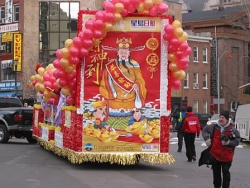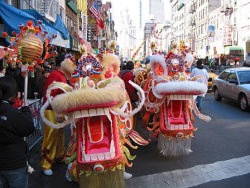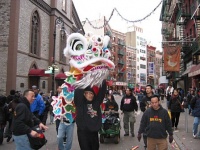From The Peopling of New York City
Contents |
Chinese New Year
In New York City today, the Chinese have shown their presence through their expanding numbers and their many cultural events. These events have caught the attention of people all around the world for the unique and exciting themes that are involved during the festivities. But one of the major events is the celebration of Chinese New Year, a day that makes the mythical dragons come to life.
History of the New Year in NYC
In 1874, one of the great festivals in Chinese culture was celebrated on the eve of Chinese New Year (February 15). Since the population of the Chinese in New York was not of great proportions as was that of other ethnicities, the celebration was not of grand scale as it is today. The New Years was celebrated in the celestial Chinese temple a short distance from the Bowery and boarding Five Points, in a rundown building on the second floor of No. 12 Baxter Street. The temple served as a place of worship, a clubroom, and a banquet ball for the, estimated, 400 Chinese that live in New York at the time. The Chinese residents worship the idol Fo and the four lesser gods, which the names of the four lesser gods translated to English reads “Light Heaven King,” “Grasp Empire Heaven King,” “Clear-Eyed Heaven King,” and Kind Heaven King,” in this temple.
The New Year’s Festival is a celebration but it also involves a great deal of religious ceremonies, the few Chinese in the area stuck to the traditions and customs of their race. Stuck to the traditions meaning the customs that they have brought with them from China.
Out of the 400 Chinamen in New York over 100 took part in celebrating Chinese New Years at the temple. On this occasion, the people dress neatly with nicely cut hair that resembled many of the other Chinamen who had similar hair. In the temple, the first room was to be used for games during this time of festivities. The game play was with pieces of wood that resembled dominos, also known as Ma-Jong. The second room was to be used for worshiping Fo, their idol. Fo was represented in a painting with many dull and gaudy colors on cheap print, which hung on the wall. Although the room was not specially cleaned compared to the other rooms and it had the appearance of the slums that the Chinese lived in, there would be a table placed in the room to serve as an altar under the painting. Offerings would be placed on this altar and as offerings they would place bouquets of flowers and place burning tapers on the center of the table, while placing saucers that held apples, nuts, and vegetables around it.
The offerings placed under their idol was not only for Fo though, it was an offering to all of their gods. Under the altar, there would be more tapers placed and colored paper pasted on the wall with writing on it, which translates into English as “Majestic Kings of Darkness,” “Shades of Ancestors and Evil Spirits do us no harm,” “Heaven King Grasp all the Empire,” “Pure Running Brook,” and other writing of similar nature.
As worship, they would come before their idol on the floor and touch their foreheads to the ground three times. After worship, they would feast on the banquet set up in the room for the celebration of the New Year, which would cost up to $75 or more. But for the cooks in charge of the banquet, the celebration would begin a few days before the actual event because they would spend the days making preparations for the feast. For the banquet, fowls and meats are served with rice and vegetables, with fruits served as well. After eating, the festival will close with the grand opium smoking. [1]
Contemporary Times: An Immigrant’s Perspective
Chinese New Year is a day of celebration where friends and family are the most important part of all the festivities. On New Years day, you would go to a friend or relatives house bearing gifts such as fruits, the fruit given usually being the orange, and giving out red envelopes. But the red envelopes are only given to young children and single people, wishing them luck, prosperity, and good health. But to be single is good during the New Years because you only collect envelopes while the married folks have to hand them out to friends and family. For Chinese New Year, most of the things are red and gold because it represents protection and prosperity.
For dinner during this day, usually chicken and roasted pigs (meats) are served with rice and vegetables. A lot of pastry is made along with these foods, such as fried dumpling called jiaozi and a salty version of the fried dumpling with meat inside. After the meal, good luck candy is shared and eaten.
Chinese New Year is a very happy day because it means that you are starting over again, starting fresh and forgetting all the bad things that have happened in the passing year. People look toward the future on this day and hope for good things to happen. For the New Years, on the eve of New Years day people shower, wear new clothing, and shoes. Along with the hope for new fortune, it is also a way to say goodbye to the lost loved ones and welcome the newborn loved ones into the world. To test their fortune, a game called Mahjong is played, thinking that since it is a new year their luck is at a peek.
The most eventful part of Chinese New Year is the parade, where the dragon dance, lion dance, unicorn dance, firecrackers, and drums are used to make a grand party. Everything during the parade is used as a method of scaring away all the bad spiritual things for the New Year as well. They also worship the gods, such as the idol Fo and the lesser gods.
In China, the New Years is as big of an event as it is in New York City. Everything done in America for this celebration is done like it is in China except for the fact that in China everyone has a whole week off to celebrate, while New York has the celebration but it is as a normal day. [2]
Funeral
The Chinese have brought many cultural aspects of their lives to New York while immigrating from Chine, many celebrations and festivities. But not all the things brought were meant for celebrations, one aspect they brought was the mourning for the dead, the funeral.
For many ethnicities, they have their own way of mourning the dead and holding funerals but for the Chinese in New York City at this time, their way of mourning was unique to society. After someone passes away, at first the mourning is in private for the nearest relatives and friends as the body is shown in a metallic case. The body is meant to be shipped to Canton, which is the only city in the world that a Chinaman can properly and safely ascend to the spirit realm, to meet already deceased ancestors. But for all this to happen, the mourners take the responsibility in protecting the soul as it ascends to the spirit world. They do everything in their power to please the good gods and try to frighten away evil spirits.
The Chinese would get permission to occupy a portion of the street and hold a public exhibition as well as a private exhibition. A Chinese priest would use a large ox horn, blowing it and letting out the shrill and sharp sounds that were meant to startle evil spirits. After blowing the horns another would come with bells and jingle and beat them for the good gods to come as the evil spirits leave. The mourners will come out in the street as the coffin is brought out and placed on the sidewalk, where there would be red, white, and green cloths draped on it. But the mourners were not all people the deceased would know; often the relatives and friends would hire mourners to cry for the dead loved ones.
There would be tables placed outside with the coffin where sacrifices are placed as well. On these tables would be full sized roasted hogs with tinsel on their ears, sheep that is skinned and lain on large pans, whole roasted chickens with many colors run over them, edible chairs where the chickens would be placed on, and the claws of the chicken were used to hold spears, darts, and exorcising wands. There would also be roosters baked with tinsels placed on them and large crabs placed in the center of the table. Along with the sacrifices on the table were piles of cakes, loaf imitations of lambs, goats, ducks, etc, and fruits: apples, pears grapes and nuts. Along with all this, there would be sacred tapers burning in rows on the table, strips of red, white and yellow paper with sacred writing on them, and figures of gods placed on the corners.
After all these things take place, they would burn tinseled paper and other possessions that would be favorable to the gods for the deceased to have a safe entry into the spirit world. One of the last events would be the fire works, as its purpose was originally to drive evil spirits away. However, over time, the use of firecrackers evolved to take on a more positive connotation. Thus they came to be said to commemorate joyous events such as wedding processions and rituals during festivals and auspicious occasions. But due to the ban of fireworks, the Chinese would hire people to make a ruckus to imitate the sounds and feel.[4]
- Return to National and Global Events
- Return to Chinese
References
- ↑ The New York Times, Feb 16, 1874, “The Chinese New Year. Idolatry In Baxter Street – Feasting and Smoking Opium,”
- ↑ Interview with Irene Tam, Brian Tam's mother
- ↑ This is an interview of Brian Tam from Queens College and his father.
- ↑ New York Times (1857-current file); December 12, 1869; ProQuest Historical Newspapers The New York Times (1851-2005) pg.3. “Curious Ceremonies- Sacrifices to the Gods- Efforts of the Mourners to Appease the Malignant Deities.”
- ↑ The Big Onion Tour, Tour guide: Jenna


